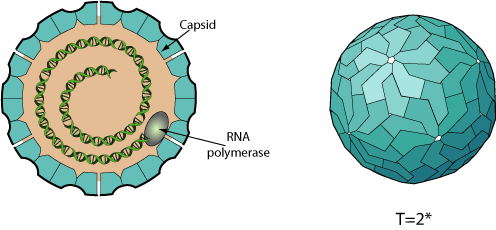Unresolvable Taxon:11006 (taxid:11006)
VIRION

Non enveloped, icosahedral virion composed of a single capsid protein (CP), about 40 nm in diameter. The capsid has a T=2* icosahedral symmetry.
GENOME
Linear dsRNA genome of 4.6-6.7 kb. Contains 2 overlapping ORFs gag and pol, respectively encoding CP and RdRp. Some totiviruses contain a third small 5'-proximal potential ORF.
GENE EXPRESSION
The dsRNA genome is never completely uncoated, to prevent activation of antiviral state by the cell in response to dsRNA. The viral polymerase synthesizes a mRNA, which is translocated to the cell cytoplasm where it is translated.
Translation is initiated on a unique internal ribosome entry site (IRES) element situated at the 5'-UTR.
In most totiviruses, the plus-strand viral transcript is flanked by a 5'untranslated region (5'-UTR) and a 3'-UTR and directs the translation of a major CP (Gag) and a minor fusion protein CP-RdRP (Gag-Pol) via a -1 ribosomal frameshift.
In other totiviruses (e.g. Hv190SV), RDRP is detected only as a separate, non-fused polypeptide and may be expressed through a termination-reinitiation mechanism.
ENZYMES
REPLICATION
CYTOPLASMIC
- Virus either remains intracellular (totivirus) or attachement to host receptors mediates endocytosis of virus into host cell (Giardiavirus).
- Transcription of the dsRNA genome by viral polymerase occurs inside the virion, so that dsRNA is never exposed to the cytoplasm. This plus-strand transcript is used as template for translation.
- (+)RNAs are encapsidated in a sub-viral particle, in which they are transcribed to give RNA (-) molecules with which they become base-paired to produce dsRNA genomes.
- Mature virions are transmitted to new cell during cell division, sporogenesis, cell fusion (totivirus) or are released from the host cell (Giardiavirus).
Matching UniProtKB/Swiss-Prot entries
(all links/actions below point to uniprot.org website)13 entries grouped by strain
3 entries
Leishmania RNA virus 1 - 1 (isolate Leishmania guyanensis) (LRV-1-1) reference strain
2 entries
Giardia lamblia virus (isolate Wang) (GLV) reference strain
2 entries
Helminthosporium victoriae virus-190S (Hv190SV) reference strain
2 entries
Saccharomyces cerevisiae virus L-A (ScV-L-A) (ScVL1) reference strain
2 entries
Saccharomyces cerevisiae virus L-BC (ScV-L-BC) (ScVLa) reference strain
1 entry
Ustilago maydis P4 virus (UmV4) (UmV-P4)
1 entry
